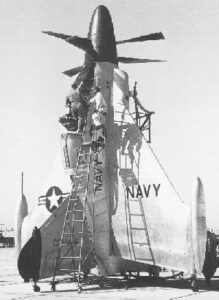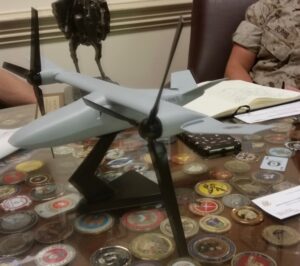Tern Tailsitter Drone: Pilot Not Included
Posted on
One of the oddest military drones aborning reinvents a stillborn technology from 1951. That’s because the unmanned aircraft revolution is resurrecting configurations that were tried more than a half century ago but proved impractical with a human pilot inside. The case in point: Northrop Grumman’s new Tern, a drone designed to do everything armed MQ-1 Predators or MQ-9 Reapers can, but to do it flying from small ships or rugged scraps of land – i.e., no runway needed.
“No one has flown a large, unmanned tailsitter before,” Brad Tousley, director of the Tactical Technology Office at the Defense Advanced Research Projects Agency (DARPA), Tern’s primary funder, said in a news release. The key word there is “unmanned.”
Back in 1951, when all sorts of vertical takeoff and landing aircraft ideas were being tried, Convair and Lockheed built experimental manned tailsitters for the Navy. Convair’s XFY-1 and Lockheed’s XFV-1, nicknamed “Pogo” and “Pogo Stick,” each had two counter-rotating propellers on its nose and was to take off and land pointing straight up. Convair’s Pogo had a delta wing and, at right angles to the wing, large fins. Lockheed’s Pogo Stick had an X-shaped tail whose trailing tips, like Convair’s wing and fins, sported landing gear.

Convair XFY-1 (U.S. Navy photo)
Those tailsitters failed, partly because it would be devilishly hard for a pilot to land on a pitching ship deck — already one of the most stressful tasks in aviation — while looking backwards as if parallel parking. The dream of vertical takeoff and landing (VTOL) fighters able to fly from destroyers went into the circular file.
With Tern, DARPA is trying to bring to life a version of that vision by foregoing the pesky pilot inside the aircraft. Northrop’s design, which DARPA chose last Christmas Eve from among five original candidates, bears a strong resemblance to the delta-wing Convair XFY-1. Tern — originally an acronym for Tactically Exploited Reconnaissance Node — is a flying wing, a favorite Northrop configuration, in delta shape, with fins at right angles to the wing, wheels on its trailing edges, and two counter-rotating propellers on its nose.
DARPA and the Office of Naval Research are covering about 73 percent of the $150 million cost of building two Tern prototypes while Northrop puts up the rest. Northrop subsidiary Scaled Composites is assembling the first Tern prototype in Mojave, Calif. The team plans to fly the “largely autonomous” drone — powered by a conventional General Electric turbine helicopter engine — in 2018 at the Army’s Yuma Proving Grounds.
Daniel Patt, who directs the program for DARPA, said the idea for an armed shipboard drone arose from Air Force difficulties satisfying the insatiable demand from combat commanders for the intelligence, surveillance, reconnaissance (ISR) and strike capabilities offered by Predators and Reapers, which are built by General Atomics Aeronautical Systems.
Patt said part of the difficulty is “not just because of physical parameters like range or distance, but sometimes because of basing.” Lack of available bases within reach of some operating areas is indeed one problem, he said, but another is the money and manpower cost of keeping not just crews to launch and recover the drones at overseas bases but also personnel to support and protect them.
The solution, Patt said, is “state of the art, medium altitude, long endurance UAV (unmanned aerial vehicle) capability – so somewhere between a Predator and Reaper, say Gray Eagle capability (the Army variant) – but from anywhere: from small ships; from expeditionary settings.” Thus one requirement for Tern is to be able to take off from a ship at sea and fly 600 to 900 nautical miles, which Patt said would put such aircraft within reach of 90 percent to 97 percent of the world’s land mass.
Neither Patt nor Northrop would provide the Tern prototype’s specifications – wing size, propeller size, etc. Patt would say only that Tern will be “the biggest thing that we can fit in the destroyer hangar.” Renderings and a video released by DARPA. he said, offer a good idea of how large the drone will be, he said. (Watch the video at the top of this page or click here).

Model of Bell’s proposed V-247 drone.
One obvious reason for keeping the specs secret is that Tern recently gained competition for eventual Navy and Marine Corps contracts. As we revealed in August and Bell Helicopter announced in September, Bell is developing the new V-247 Vigilant, aimed at meeting a Marine Corps requirement for a sea-based drone called MUX, and Karem Aircraft is working on one called “Swift.” Bell’s and Karem’s both are tiltrotors, a VTOL configuration also first tried in the 1950s as a manned aircraft but which, unlike the tailsitters, worked.
Lt. Gen. Jon “Dog” Davis, deputy commandant of the Marine Corps for aviation, is eager to get a ship-based armed drone able to do what Predators, Reapers and Gray Eagles do and provide an airborne “picket line” for ships. But Davis has said he also wants a drone that could be an armed scout and escort for the Marines’s V-22 Osprey tiltrotor troop transport, built by Bell in partnership with Boeing Co.
In his Pentagon office, Davis has a model of Bell’s V-247. So far, no model of a Tern or Swift.
Subscribe to our newsletter
Promotions, new products and sales. Directly to your inbox.
